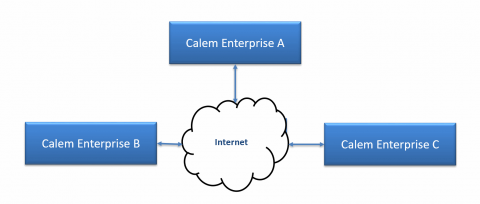Calem Blogs
How to Integrate with Calem
This is a summary of integration options available in Calem. They are organized into the following parts:
- API Integration - a third party application uses Calem REST API to integrate with Calem
- Event Subscription - a third party application uses REST API to receive Calem data change events
- Email Integration - Calem reads inbound emails to create data in Calem; Calem sends notification emails to users.
- Custom Trigger - Add custom business logic to Calem
- Remote inventory - search and request inventory from other Calem services
- Metadata Deployment - use a centralized Calem service to customize data and screens. The customization metadata is pushed to remote Calem services.
1. REST API Integration
A third party application uses Calem REST API to query, create, or update data in Calem. For instance, a device monitoring service may detect device failure and create a service request, or a work order in Calem. See more info in this blog.
2. Event Subscription
A third party application subscribes to data change events from Calem. For instance, whenever an IP address is changed in an asset, a third party is notified of the IP change event. The data change event includes the asset, location, and the previous and new IP addresses. See more info in this blog.
2.1 Report Subscription
Users can be configured to receive ad-hoc reports from Calem regularly (such as daily, weekly, or monthly). See this blog for more info.
3. Email Integration
Calem can be configured to read inbound emails and update Calem. For instance, Calem can read inbound email to create a service request; or read reply from a Calem workflow notification email to add comments, or attachments. Calem can be configured to send workflow notifications via email. See this blog for more info.
4. Custom Triggers
Custom trigger allows an integrator to add custom business logic without updating Calem. For instance, each vendor must have an NDA agreement on file before a PO is issued. This business requirement can be implemented by adding custom field (for NDA agreement on file) and custom trigger to enforce the requirement. See this blog for more information.
5. Remote Inventory
Remote inventory allows users from one Calem service to query and request inventory in another Calem service. This feature allows customers to have multiple organizational units sharing inventory and fast-tracking the acquisition of critical spare parts. See this blog for more info.
6. Metadata Deployment Tool
The deployment tool simplifies the service management for organizations with many Calem cloud services. For instance, an organization uses many Calem Cloud Services for their external and internal customers. It is tedious and time consuming to set up the groups/roles, modules, and screens repetitively in each of the service instances. The Multi-Service Deployment Tool saves a lot of time in creating new services and keeping all of them up to date.
See this blog for more info.
Additional Resources
- Calem Integration Part I: Email & Misc Integration
- Calem Integration Part II: RESP API
- Calem Integration Part III: Custom Triggers
- Calem Integration Part IV: How to Subscribe to Data Changes in Calem
- Monitoring Service Integration
- Calem Remote Inventory Management
- Calem Remote Deployment Tool
- Calem Scheduled Reports
- Calem Enterprise REST API Guide (customer account required)
- User Guide and Admin Guide (customer account required)
- Calem Enterprise Training Site
- Calem Enterprise Blogs
- Calem Enterprise demo
Related Posts
By accepting you will be accessing a service provided by a third-party external to https://calemeam.com/




